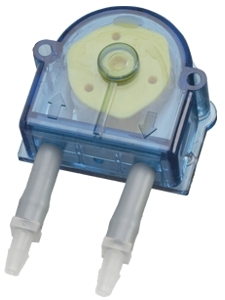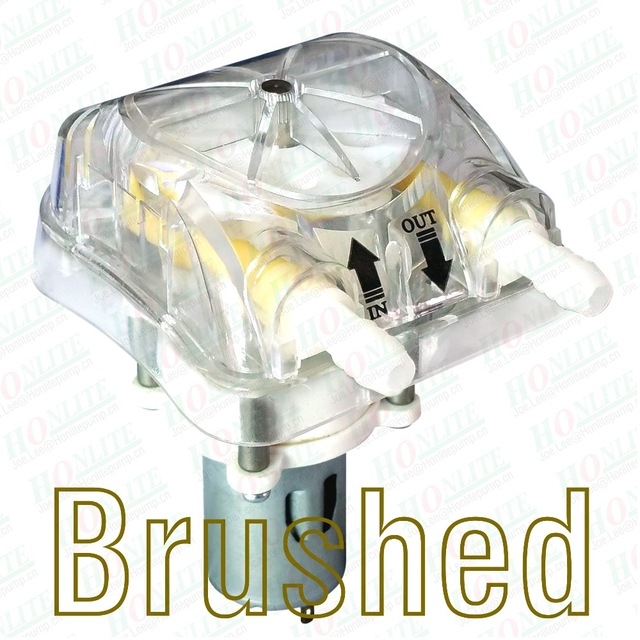Abstract
There are currently two pumps to choose from for the OPEnSampler: a low flow rate, unknown-precision peristaltic pump and a high flow rate, “low precision” pump. They have their pros and cons and this writeup will discuss the angles of attack for deciding which one is more appropriate for our system.
Specs:
The WMC Pump has the following specs:
- 12V DC 400mA
- 297 mL/min flow rate, among other lower flow rate options
- 5mm Viton Tubing, among other options
- Barbed Fittings
The Honlite Pump has the following specs:
- 12V DC 1.2A – 3.2A
- 1100 +- 8% mL/min flow rate
- Tygon Tubing, among other options
- Compression fittings for 1/4” OD tubing, among other options
Discussion


WMC Pump Head
The WMC pump has been tested on our prototype system and has proven to be reliable and true to its specs. It can reliably pump 250mL/min of water at zero net suction head, which is about three times as fast as our previous dual-pump system. Despite such an improvement, the flow rate is still quite low for attaining representative samples of suspended sediments, such as fine-grain sands [source]. A flow rate of 530+ mL/min is required to reach the EPA’s recommended 60 cm/s minimum line velocity for such sampling where the flow of the analyte heavily relies on the mass and specific gravity of the particulates [source].


Honlite Peristaltic Pump
The Honlite pump from AliExpress has yet to be tested however the manufacturer supplies more specifications than the WMC pump. The defining characteristic of this pump is its 1100 mL/min flow rate at 12VDC, almost 4 times the rated flow rate of the WMC pump and twice the minimum recommended flow rate for sampling suspended solids. Some downsides are its high variance in flow rate of 8%, though further testing of the WMC pump could prove this is not an usual variance, and further testing of the Honlite pump could prove this variance is controllable. The pump head only has two rollers (three is standard) and so the rhythm of the pump could be noticeable, but will quite likely have a negligible effect on the sample quality.
One method of fixing the inconsistency of any pump used is to add a flow rate meter in series with the pump line. This flow rate meter can catch when the pump is struggling or increases its velocity significantly and adjust the PWM control of the pump driver chip, effectively increasing or decreasing the voltage supplied across the pump to account for the change in flow.
Conclusion:
Both pumps cost around $65 (the Honlite pump costs $30 with $35 shipping to the US) so reliability and flow rate are the most significant factors. Neither pump states its maximum suction head, though almost all peristaltic pumps seem to have a maximum suction head greater than 5m. This is why the Honlite pump was chosen for the Q4 2017 design, but several WMC pumps will be purchased as backups in the event we find the Honlite product to be faulty.
It is quite difficult to find a peristaltic pump with a sufficient flow rate for such a low cost and this is the primary source of skepticism for using the Honlite pump. How are they able to achieve such a large flow rate without increasing cost? The answer could be they are mass producing these pumps in a highly efficient system, or perhaps their pumps are not as reliable. Consistency in sample volume may not be a large concern, however an inconsistent sample volume is almost exclusively caused by a varying velocity of sampled water in the tubes. This varying velocity can certainly lead to varying turbidity and suspended solids measurements [source] [source], and so consistency is a huge factor in choosing a pump.
